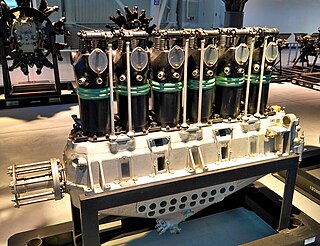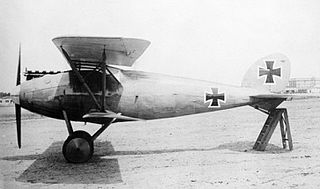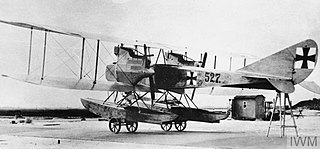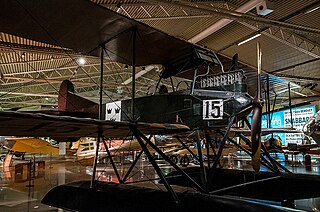
The Albatros C.III was a German two-seat general-purpose biplane of World War I, built by Albatros Flugzeugwerke. The C.III was a refined version of the successful Albatros C.I and was eventually produced in greater numbers than any other C-type Albatros.

The Albatros Dr.II was a German prototype single-seat fighter triplane, the sole example of which flew in the spring of 1918. It was similar in many respects to the D.X biplane, employing among other features the same 145 kW (195 hp) Benz Bz.IIIbo engine and twin 7.92 mm (.312 in) machine guns.

The Benz Bz.IV was a German six-cylinder, water-cooled, inline engine developed for aircraft use. Deliveries began in 1916, and some 6,400 were produced.

The LFG Roland C.II, usually known as the Walfisch (Whale), was an advanced German reconnaissance aircraft of World War I. It was manufactured by Luft-Fahrzeug-Gesellschaft G.m.b.H.

The Albatros C.II was a 1910s German military pusher reconnaissance biplane designed and built by Albatros Flugzeugwerke. Only one aircraft was built and the type did not enter production.
The Junkers T 23 was a two-seat, single-engined experimental training aircraft, built in Germany in the early 1920s. It could be configured either as a parasol winged monoplane or as a biplane to compare handling characteristics. 4 were constructed.
The Sopwith Admiralty Types 137 and 138 were a pair of single-engine, two-seat naval biplane floatplanes, built to a British Admiralty order in 1914. They were similar in design, but having a more powerful engine the Type 138 was the larger and heavier. They were used in early torpedo dropping experiments in 1914.
The NAVO RK-4/220 was a Dutch aircraft originally designed for unofficial crowd observation but which was completed as an airliner. Only one was built; it flew, but was never certified.

The Kondor D 7 was a prototype German single seat biplane fighter built over the winter of 1917-18. It was not a success and its development was soon abandoned.

The Pfalz D.XV was a German single seat fighter aircraft which was approved for production right at the end of World War I, too late to enter service.

The Schoettler I was one of the first aircraft constructed in China, albeit with a German designer. It was a two-seat, single engine biplane, first flown in mid-summer 1923.

The Luft-Fahrzeug-Gesellschaft (LFG) Roland D.VII was a German single seat, single engine biplane fighter aircraft built during World War I. Problems with its underdeveloped V-8 engine prevented its production.

The LFG Roland D.XV was a World War I German single seat fighter aircraft, ordered as a test-bed for engine comparisons. It was distinguished from earlier Roland biplane designs by the elimination of flying wires. Two later aircraft, also called LFG Roland D.XV, were completely different designs with slab sided fuselages.

The LFG Roland G.I was a large prototype single-engine biplane bomber built in Germany in 1915, during World War I. It had a single engine buried in the fuselage driving pusher configuration propellers mounted on outriggers.

The Albatros C.XIII was a German two-seat, single-engine, biplane light fighter aircraft built in 1917. Only one was constructed.

The Albatros W.3, company designation VT, was a biplane torpedo bomber floatplane prototype, built for the Imperial German Navy during the First World War. Only one was built.

The Albatros L.71 was a two-seat, single pusher engined biplane built in Germany in the 1920s.

The Thulin G was a Swedish military reconnaissance aircraft built in the late 1910s.

The Thulin FA was a Swedish reconnaissance aircraft built in the late 1910s.
The Kawanishi K-3 was a Japanese, fast, multi-purpose civil transport aircraft from the early 1920s. Despite its good performance it was eclipsed by the release of Army surplus machines and only one was built.
















